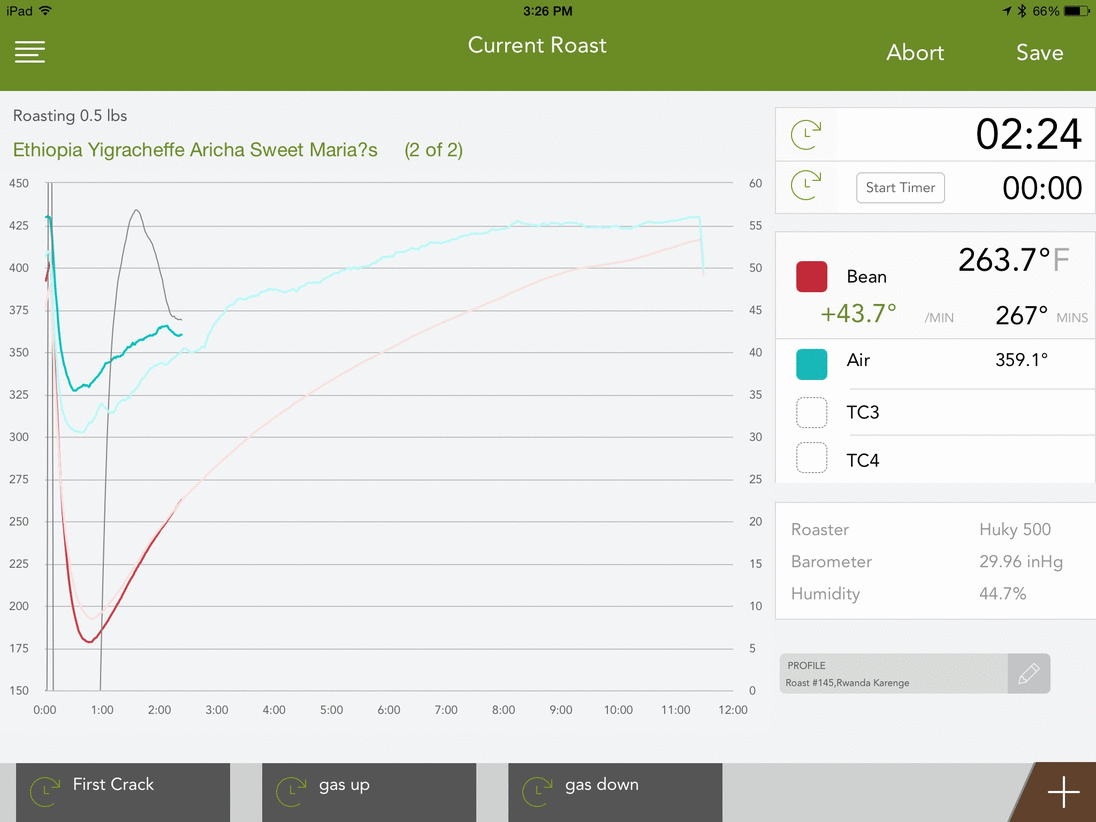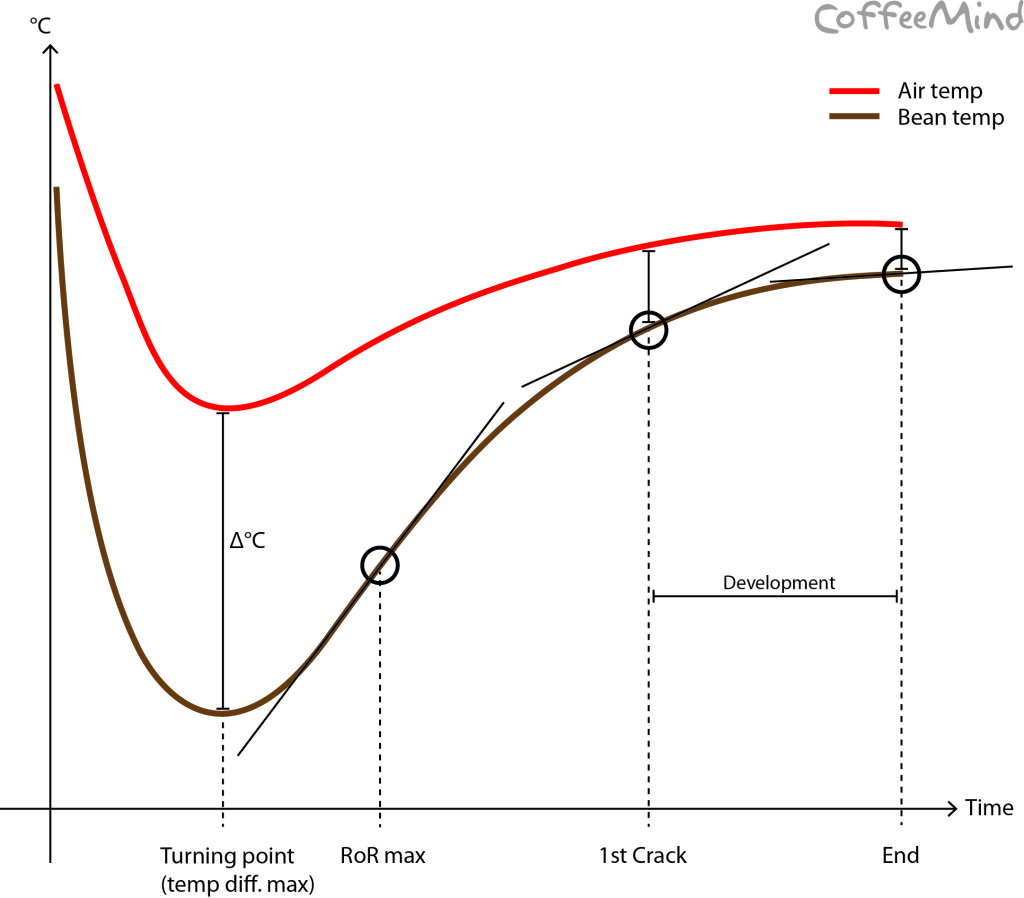There is no denying that the science and experimentation of coffee roasting are alive and well within the industry these days. The tinkering and optimizing remind me so much of the so-called maker movement. One of the most heralded terms being batted around these days is heating rate, or rate-of-rise as it’s commonly referred.
What’s in a name…
Whether you prefer to call it the rate-of-rise/R-o-R/RoR, or our preference: the heating rate, understanding how quickly the temperature of the coffee beans rises and falls during roasting is arguably as useful if not more than recording bean temp by itself. Who would have guessed a little bit of simple high school calculus could be such a game changer? So, with all the attention it seems to be getting these days, we thought it was worth exploring this key RoastLog feature.
Much of the buzz around heating rate is being generated by members of the roasting community. In fact, it’s difficult to attend a specialty coffee conference, Roasters Guild retreat or coffee roasting event without it coming up in discussion – and for good reason, as it’s proven its worth as an invaluable tool for guiding roast profile development and understanding the unique characteristics of one’s own roasting equipment.
Logging heating rate: A perfect complement to recording air and bean temp
Understanding heating rate, merits some talk of tracking enviro air temp in addition to bean temperature on drum roasters. A few years back, we hosted a guest blog post about how the interplay between bean and air temp provided insights into the thermal dynamics of roasting equipment and helped roasters anticipate how quickly heat applied to the drum will translate to the beans.
When we introduced our first 4-input data bridge we were finally able to equip our users with the logging device needed to simultaneously record both bean and air temps. Since the air in the drum is much more responsive to changes in airflow and gas pressure, the environmental air temp in the drum is a bellwether for heat transferring from the system into the beans.
Adding in the heating rate/RoR completes the air temp/bean temp/heating rate trifecta, allowing roasters the ability to get realtime feedback on their flame adjustments and to see how rapidly bean temp changes during roasting.

Heating rate as recorded in the iPad app.
It’s worth reiterating that RoastLog users have the ability to visualize this information while actually roasting which, in turn, makes this info actionable. As a result, roasters gain yet another tool in the effort to get consistency and quality from their roasting operations.
The value of monitoring heating rate
Knowledgable folks like Morten Münchow espouse the benefits of tracking the rate of temperature change when performing roast profile analysis and while dialing in roast profiles. In fact, one of the clearest explanations I’ve seen for heating rate/RoR – and the value of tracking it during roasting – is on Münchow’s blog at Coffee-Mind.com. However, he’s not alone amongst the evangelists. Profile analysis and development have become staples during coffee roaster trainings. Numerous coffee courses including, but not limited to, Coffee International, Boot Coffee Consulting and regular offerings from the Roaster’s Guild cover the topic. One need not go much further than Scott Rao’s book, The Coffee Roaster’s Companion, for what amounts to a clinical dissection of heating rate and it’s impact on roast development – one the main pillars of Rao’s Three Commandments of Roasting.

Tangential lines representing heating rate at points along the profile. Courtesy Morten Münchow, http://coffee-mind.com
Coffee roasters are increasingly using these types of tools to better understand and anticipate the progression of their roasts. With these tools comes control, clarity and a way to measure what previously was observed empirically. A perfect example is how heating rate informs roasters on how/when to adjust the application of heat to avoid pitfalls such as stalling and scorching. These were events that, not very long ago, were things that a roaster was more likely to sense than measure.
More insight translates to better control and the ability to optimize the energy going into the roast.
In turn, a new generation of roasters is emerging – many who are honing their skills and mastering a craft in an incredibly short period of time. We’re generating a vast body of knowledge around roasting that is systematically raising the bar on coffee quality. We’re just happy that we get to be a part of this movement.
2 Comments
David Green · September 17, 2016 at 1:23 pm
You have gone in great detail to explain how to roast and the right temperature, but I guess this is all well and good with a machine. Nowadays, a lot of people are looking to do things more ‘naturally’ and manually, where things can not be repeated exactly the same way again and again leading to inconsistency. Some people like that. For a cafe or a professional barista, going in such details will obviously help but I am sure, this is not great for someone at home?
Linsey Fan · September 17, 2016 at 4:32 pm
Admittedly, we tend to have a commercial-centric view on these things… However, the proliferation of roast profiling software (including numerous open-source options geared towards ‘enthusiasts’) seems to indicate that home roasters are just as likely to go to lengths to understand the dynamics of their particular roasting system as any commercial roaster. Reproducibility need not be the only goal. Profiling is arguably more about becoming familiar with your roaster so that one can tease out the character of a particular coffee.
Comments are closed.